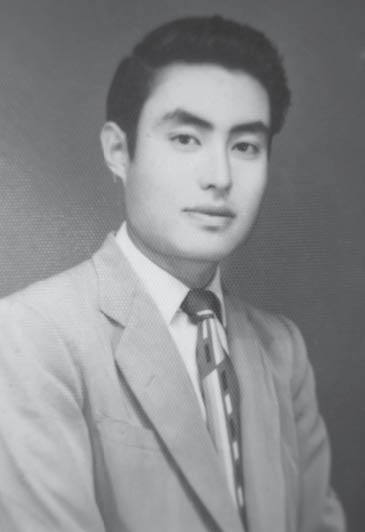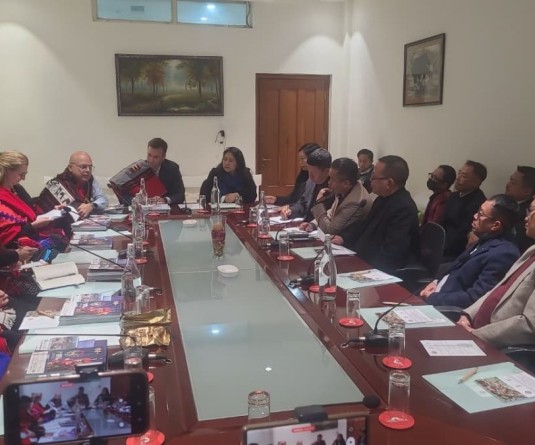Tiatemjen, second son of NNC vice president Imkongmeren.

Morung Express News
Dimapur | August 31
For the family of ‘captain’ Tiatemjen, the road has been as long and arduous, as was for him when constant persecution from the Indian Army authorities forced him to join the FGN in August 1963. The path he chose would take him to Burma, thousands of miles away from his homeland. 41 years later, August 25, the mortal remains of the Naga fighter, slain by the Burmese army would be brought home. Family members narrated the life of Tiatemjen, a life of giving and sacrifice for a cause he chose for himself.
Tiatemjen was the second son of NNC vice president Imkongmeren. Born in 1938, Tiatemjen started his early education from Mokokchung LP School which he joined in 1951 and later enrolled in Mokokchung Government Middle School, in 1953. He then joined the “Naga National High School” but two years later in July 1955, it was forcefully occupied by the Indian Army and so was shut down.
Forced to make another change, he and his younger brother Imimatong joined Impur Mission High School in February 1956. Fate played a hand again. The same month, on February 28, both were arrested and jailed in Mokokchung by the government of India for a year without trial. Their only crime was that their father was in the Naga political movement. After their release in 1957 he and his brother went to Calcutta and enrolled in the Calcutta Boys School.
It was said that shortly after they joined, the Indian government issued a warning to the school administration not to provide education to them. Consequently, the two were asked to leave by the school administration.
On their return home, family members said, they were further harassed and had to sign in every morning and night at the Police Thana and were not allowed to leave Mokokchung. Due to extreme harassment Tiatemjen left for Shillong in 1959 and enrolled at Mawkher Christian High School and was there till 1962. During that time, his mother fell ill and he had to return home – to more harassment from the Indian authorities. On August 19, 1963, Tiatemjen joined the ‘Naga army 7th brigade’ and over the years climbed to the rank of ‘captain.’
The following year, in 1964 a ceasefire was declared. In February1968, three months after his marriage, ‘captain’ Tiatemjen was transferred to the ‘alee command’ of the FGN. With 320 Naga fighters, Tiatemjen reached the Kachin Independent Army’s 2nd brigade headquarter in the last week of April, 1968. On reaching there they could not venture any further due to political reasons and had to return, family members said.
On their way back they camped at Thangkao at the onset of monsoon. They then crossed the Chinwin River by rafts and during which three of his comrades lost their lives. Shortly, they crossed into Tekete area. Soon, after proceeding from Chinwin River they encountered the Burmese army and a fierce gun battle followed from where the Naga fighters withdrew and took a diversion to escape. But by then, the group was surrounded by the Burmese Army. Following the encounter the next night, the main group was split into many smaller units to avoid the Burmese army. Tiatemjen and 13 of his comrades were in one group. Two days later, the fourteen of them encountered the Burmese army again. In the gun battle around a village called Yangoon village on the 10th of May 1968, ‘captain’ Tiatemjen lost his life. From the 320 Naga fighters, 25 were killed.
Ever since, efforts were made to retrieve his remains, for Nagas have a tradition to lay the mortal remains of their people in own homeland. His father’s (the vice president of the NNC Imkongmeren) last wish before his demise in 1979 was to get his son’s remains back home. Unfortunately, situations during that time did not permit so.
The responsibility was taken up by Tiatemjen’s brothers Imimatong and Imtiyanger. Since 1980, both to fulfill their father’s wish and theirs too it has been a long and tiring search beginning with meeting all those who were together with him till the end. Years went by in gathering information and lead to pinpoint the location where he was last left; scouring through all available sources. With God’s grace their journey for the search for their slain brother’s neared to an end.
With the help of missionaries in 2009 they got in touch with the people of Yangoon village area and asked two young Naga men from that region to carry out the task. The two young men left for Yangoon village on the morning of May 30, 2009 and returned with the mortal remains of ‘captain’ Tiatemjen, on August 25, 2009, 41 years after the fateful encounter with the Burmese army at Yangoon village in 1968. The mortal remains of Tiatemjen was finally laid to rest in his native village of Longkhum on August 27, 2007.






